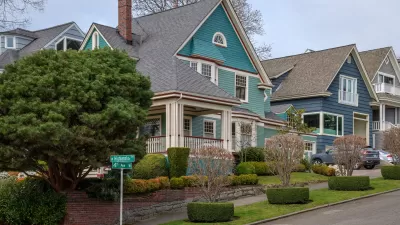The new form-based code for the Kentucky city of Covington went into effect on October 15. Officials are promoting the simplicity of the new code to the public.

Monique John provides a bit of explanation about the city of Covington's new form-based code, as the city's new code took effect late last week. First, a little background on why Covington officials felt like the time was right for this major change in the approach to development regulations:
Officials felt creating this new code was necessary, saying past zoning regulations made development projects expensive and time consuming. Despite what kind of building or additions locals were looking to develop, they had to get approval from two separate boards, which could be very difficult. Plus, officials felt the zoning regulations were outdated.
Covington officials are also promising that the code will be much easier to use, cutting down significantly on the number of pages devoted to zoning in the city's development code.
In addition to helping streamline the development approvals process, city officials also chose a form-based code to "focus less on how buildings will be used and more on the design of a property and how it fits in the neighborhood." The hope is that the form-based approach will help "preserve the history and character of the Covington community" and "create a more walkable, mixed-use environment," according to John.
Planetizen picked up news of the city's Neighborhood Development Code at the time of adoption in September.
FULL STORY: Covington rolls out a simpler redevelopment code

Maui's Vacation Rental Debate Turns Ugly
Verbal attacks, misinformation campaigns and fistfights plague a high-stakes debate to convert thousands of vacation rentals into long-term housing.

Planetizen Federal Action Tracker
A weekly monitor of how Trump’s orders and actions are impacting planners and planning in America.

In Urban Planning, AI Prompting Could be the New Design Thinking
Creativity has long been key to great urban design. What if we see AI as our new creative partner?

King County Supportive Housing Program Offers Hope for Unhoused Residents
The county is taking a ‘Housing First’ approach that prioritizes getting people into housing, then offering wraparound supportive services.

Researchers Use AI to Get Clearer Picture of US Housing
Analysts are using artificial intelligence to supercharge their research by allowing them to comb through data faster. Though these AI tools can be error prone, they save time and housing researchers are optimistic about the future.

Making Shared Micromobility More Inclusive
Cities and shared mobility system operators can do more to include people with disabilities in planning and operations, per a new report.
Urban Design for Planners 1: Software Tools
This six-course series explores essential urban design concepts using open source software and equips planners with the tools they need to participate fully in the urban design process.
Planning for Universal Design
Learn the tools for implementing Universal Design in planning regulations.
planning NEXT
Appalachian Highlands Housing Partners
Mpact (founded as Rail~Volution)
City of Camden Redevelopment Agency
City of Astoria
City of Portland
City of Laramie





























